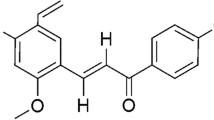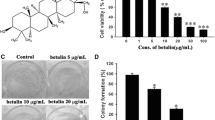Abstract
Berberine is the major constituent of Coptidis Rhizoma with multiple pharmacological activities, including anti-inflammation, promotion of apoptosis and anticancer potential effect. Mitogen-activated protein kinase (MAPK) and reactive oxygen species (ROS) may contribute to the causal relationship between tumorigenesis and pro-apoptotic function. Berberine is studied for the mechanism of its action in apoptotic pathway in human colonic carcinoma cell. Treatment of SW620 cells with 50 μM berberine resulted in activation of the caspase 3 and caspase 8, cleavage of poly ADP-ribose polymerase (PARP) and the release of cytochrome c; whereas, the expression of BID and anti-apoptosis factor c-IAP1, Bcl-2, and Bcl-XL were decreased markedly. Berberine-induced, dose-dependent induction of apoptosis was accompanied by sustained phosphorylation of JNK and p38 MAPK, as well as generation of the ROS. Furthermore, the induction of apoptosis was alleviated by inhibitors specific for JNK and p38. In addition, there was an increase in the cellular levels of phospho-c-Jun, FasL and t-BID in the berberine-induced apoptosis via the activation of JNK and p38 signaling modules. NAC administration, a scavenger of ROS, reversed berberine-induced apoptosis effects via inhibition of JNK, p38 and c-jun activation, and FasL and t-BID expression. These results leads us to speculate that berberine may play an apoptotic cascade in SW620 cells by activation of the JNK/p38 pathway and induction of ROS production, providing a new mechanism for berberine-induced cell death in human colon cancer cells.








Similar content being viewed by others
References
Agarwal C, Sharma Y, Zhao J, Agarwal R (2000) A polyphenolic fraction from grape seeds causes irreversible growth inhibition of breast carcinoma MDA-MB468 cells by inhibiting mitogen-activated protein kinases activation and inducing G1 arrest and differentiation. Clin Cancer Res 6:2921–2930
Akhter MH, Sabir M, Bhide NK (1977) Anti-inflammatory effect of berberine in rats injected locally with cholera toxin. Indian J Med Res 65:133–141
Amin AH, Subbaiah TV, Abbasi KM (1969) Berberine sulfate: anti-microbial activity, bioassay, and mode of action. Can J Microbiol 15:1067–1076
Anis KV, Rajeshkumar NV, Kuttan R (2001) Inhibition of chemical carcinogenesis by berberine in rats and mice. J Pharm Pharmacol 53:763–768
Assefa Z, Vantieghem A, Garmyn M, Declercq W, Vandenabeele P, Vandenheede JR, Bouillon R, Merlevede W, Agostinis P (2000) p38 mitogen-activated protein kinase regulates a novel, caspase-independent pathway for the mitochondrial cytochrome c release in ultraviolet B radiation-induced apoptosis. J Biol Chem 275:21416–21421
Bova S, Padrini R, Goldman WF, Berman DM, Cargnelli G (1992) On the mechanism of vasodilating action of berberine: possible role of inositol lipid signaling system. J Pharmacol Exp Ther 261:318–323
Camhi SL, Lee P, Choi AM (1995) The oxidative stress response. New Horiz 3:170–182
Chen C, Kong A.N (2005) Dietary cancer-chemopreventive compounds: from signaling and gene expression to pharmacological effects. Trends Pharmacol Sci 26:318–326
Chen F, Lu Y, Zhang Z, Vallyathan V, Ding M, Castranova V, Shi X (2001) Opposite effect of NF-κB and c-Jun N-terminal kinase on p53-independent GADD45 induction by arsenite. J Biol Chem 276:11414–11419
Cho BJ, Im EK, Kwon JH, Lee KH, Shin HJ, Oh J, Kang SM, Chung JH, Jang Y (2005) Berberine inhibits the production of lysophosphatidylcholine-induced reactive oxygen species and the ERK1/2 pathway in vascular smooth muscle cells. Mol Cells 20:429–434
Crow JP (1997) Dichlorodihydrofluorescein and dihydrorhodamine 123 are sensitive indicators of peroxynitrite in vitro: implications for intracellular measurement of reactive nitrogen and oxygen species. Nitric Oxide 1:145–157
Davis W. Jr, Ronai Z, Tew K.D (2001) Cellular thiols and reactive oxygen species in drug-induced apoptosis. J Pharmacol Exp Ther. 296:1–6
Enari M, Sakahira H, Yokoyama H, Okawa K, Iwamatsu A, Nagata S (1998) A caspase-activated DNase that degrades DNA during apoptosis, and its inhibitor ICAD. Nature 391:43–50
Fukuda K, Hibiya Y, Mutoh M, Koshiji M, Akao S, Fujiwara H (1999) Inhibition by berberine of cyclooxygenase-2 transcriptional activity in human colon cancer cells. J Ethnopharmacol 66:227–233
Hatai T, Matsuzawa A, Inoshita S, Mochida Y, Kuroda T, Sakamaki K, Kuida K, Yonehara S, Ichijo H, Takeda K (2000) Execution of apoptosis signal-regulating kinase 1 (ASK1)-induced apoptosis by the mitochondria-dependent caspase activation. J Biol Chem 275:26576–26581
Hengartner MO (2000) The biochemistry of apoptosis. Nature 407:770–776
Hu R, Kong AN (2004) Activation of MAP kinases, apoptosis and nutrigenomics of gene expression elicited by dietary cancer-prevention compounds. Nutrition 20:83–88
Hwang JM, Kuo HC, Tseng TH, Liu JY, Chu CY (2006) Berberine induces apoptosis through a mitochondria/caspases pathway in human hepatoma cells. Arch Toxicol 80:62–73
Hwang JM, Wang CJ, Chou FP, Tseng TH, Hsieh YS, Lin WL, Chu CY (2002) Inhibitory effect of berberine on tert-butyl hydroperoxide-induced oxidative damage in rat liver. Arch Toxicol 76:664–670
Ichijo H (1999) From receptors to stress-activated MAP kinases. Oncogene 18:6087–6093
Jacobson MD (1996) Reactive oxygen species and programmed cell death. Trends Biochem Sci 21:83–86
Kettmann V, Kosfalova D, Jantova S, Cernakova M, Drimal J (2004) In vitro cytotoxicity of berberine against HeLa and L1210 cancer cell lines. Pharmazie 59:548–551
Kuo CL, Chou CC, Yung BY (1995) Berberine complexes with DNA in the berberine-induced apoptosis in human leukemic HL-60 cells. Cancer Lett 93:193–200
Kuo HC, Lee HJ, Hu CC, Shun HI, Tseng TH (2006) Enhancement of esculetin on taxol-induced apoptosis in human hepatoma HepG2 cells. Toxicol Appl Pharmacol 210:55–62
Kuo WH, Chen JH, Lin HH, Chen BC, Hsu JD, Wang CJ (2005) Induction of apoptosis in the lung tissue from rats exposed to cigarette smoke involves p38/JNK MAPK pathway. Chem Biol Interact 155:31–42
Lin CC, Kao ST, Chen GW, Ho HC, Chung JG (2006) Apoptosis of human leukemia HL-60 cells and murine leukemia WEHI-3 cells induced by berberine through the activation of caspase-3. Anticancer Res 26:227–242
Lin HL, Liu TY, Wu CW, Chi CW (1999a) Berberine modulates expression of mdr1 gene product and the responses of digestive track cancer cells to paclitaxel. Br J Cancer 81:416–422
Lin JG, Chung JG, Wu LT, Chen GW, Chang HL, Wang TF (1999b) Effects of berberine on arylamine N-acetyltransferase activity in human colon tumor cells. Am J Chin Med 27:265–275
Malhi H, Gores GJ, Lemasters JJ (2006) Apoptosis and necrosis in the liver: a tale of two deaths? Hepatology 43:S31–S44
Manna SK, Mukhopadhyay A, Van NT, Aggarwal BB (1999) Silymarin suppresses TNF-induced activation of NF-kappa B, c-Jun N-terminal kinase, and apoptosis. J Immunol 163:6800–6809
Manson MM (2003) Cancer prevention—the potential for diet to modulate molecular signalling. Trends Mol Med 9:11–8
Mansouri A, Ridgway LD, Korapati AL, Zhang Q, Tian L, Wang Y, Siddik ZH, Mills GB, Claret FX (2003) Sustained activation of JNK/p38 MAPK pathways in response to cisplatin leads to Fas ligand induction and cell death in ovarian carcinoma cells. J Biol Chem 278:19245–19256
Nagata S (2000) Apoptotic DNA fragmentation. Exp Cell Res 256:12–18
Nishi T, Shimizu N, Hiramoto M, Sato I, Yamaguchi Y, Hasegawa M, Aizawa S, Tanaka H, Kataoka K, Watanabe H, Handa H (2002) Spatial redox regulation of a critical cysteine residue of NF-κB in vivo. J Biol Chem 277:44548–44556
Richer C, Cogvadze V, Laffranchi R, Schlapbach R, Schweizer M, Suter M (1995) Oxidants in mitochondria: from physiology to diseases. Biochim Biophys Acta 127:67–74
Rahman I, MacNee W (1998) Role of transcription factors in inflammatory lung diseases. Thorax 53:601–612
Rothe G, Valet G (1990) Flow cytometric analysis of respiratory burst activity in phagocytes with hydroethidine and 2′,7′-dichlorofluorescin. J Leukoc Biol 47:440–448
Saeki K, Kobayashi N, Inazawa Y, Zhang H, Nishitoh H, Ichijo H, Isemura M, Yuo A (2002) Oxidation-triggered c-Jun N-terminal kinase (JNK) and p38 mitogen-activated protein (MAP) kinase pathways for apoptosis in human leukaemic cells stimulated by epigallocatechin-3-gallate (EGCG): a distinct pathway from those of chemically induced and receptor-mediated apoptosis. Biochem J 368:705–720
Simon HU, Haj-Yehia A, Levi-Schaffer F (2000) Role of reactive oxygen species (ROS) in apoptosis induction. Apoptosis 5:415–418
Stennicke HR, Salvesen G.S (2000) Caspases—controlling intracellular signals by protease zymogen activation. Biochim Biophys Acta 1477:299–306
Tobiume K, Saitoh M, Ichijo H (2002) Activation of apoptosis signal-regulating kinase 1 by the stress-induced activating phosphorylation of pre-formed oligomer. J Cell Physiol 191:95–104
Tournier C, Hess P, Yang DD, Xu J, Turner TK, Nimnual A, Bar-Sagi D, Jones SN, Flavell RA, Davis RJ (2000) Requirement of JNK for stress-induced activation of the cytochrome c-mediated death pathway. Science 288:870–874
Tsai CS, Ochillo RF (1991) Pharmacological effects of berberine on the longitudinal muscle of the guinea-pig isolated ileum. Arch Int Pharmacodyn Ther. 310:116–131
Van den Berg R, Haenen GR, van den Berg H, Bast A (2001) Transcription factor NF-κB as a potential biomarker for oxidative stress. Br J Nutr 86(Suppl 1):S121–S127
Wang J, Zhao L, Lin D. (1997) Differentiation-inducing effect of stepholidine and retinoic acid on human head and neck carcinoma. Zhonghua Er Bi Yan Hou Ke Za Zhi 32:99–102
Wang X (2001) The expanding role of mitochondria in apoptosis. Genes Dev 15:2922–2933
Weber HA, Zart MK, Hodges AE, Molloy HM, O’Brien BM, Moody LA, Clark AP, Harris RK, Overstreet JD, Smith CS (2003) Chemical comparison of goldenseal (Hydrastis canadensis L.) root powder from three commercial suppliers. J Agric Food Chem 51:7352–7358
Wu HL, Hsu CY, Liu WH, Yung BY (1999) Berberine-induced apoptosis of human leukemia HL-60 cells is associated with down-regulation of nucleophosmin/B23 and telomerase activity. Int J Cancer 81:923–929
Yang IW, Chou CC, Yung BY (1996) Dose-dependent effects of berberine on cell cycle pause and apoptosis in Balb/c 3T3 cells. Naunyn Schmiedebergs Arch Pharmacol 354:102–108
Yuo A (2001) Differentiation, apoptosis, and function of human immature and mature myeloid cells:intracellular signaling mechanism. Int J Hematol 73:438–452
Zhang Y, Chen F (2004) Reactive oxygen species (ROS), troublemakers between nuclear factor-kappaB (NF-κB) and c-Jun NH(2)-terminal kinase (JNK). Cancer Res 64:1902–1905
Acknowledgment
This study was supported by the Armed-Force Taichung General Hospital (grant number 0930001807) Republic of China.
Author information
Authors and Affiliations
Corresponding authors
Rights and permissions
About this article
Cite this article
Hsu, WH., Hsieh, YS., Kuo, HC. et al. Berberine induces apoptosis in SW620 human colonic carcinoma cells through generation of reactive oxygen species and activation of JNK/p38 MAPK and FasL. Arch Toxicol 81, 719–728 (2007). https://doi.org/10.1007/s00204-006-0169-y
Received:
Accepted:
Published:
Issue Date:
DOI: https://doi.org/10.1007/s00204-006-0169-y




